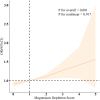The association between magnesium depletion score (MDS) and overactive bladder (OAB) among the U.S. population
- PMID: 40181471
- PMCID: PMC11969968
- DOI: 10.1186/s41043-025-00846-x
The association between magnesium depletion score (MDS) and overactive bladder (OAB) among the U.S. population
Abstract
Objective: This study aimed to assess the relationship between magnesium depletion score (MDS) and overactive bladder (OAB) prevalence.
Methods: This study utilized data from the National Health and Nutrition Examination Survey (NHANES) from 2005 to 2018. Multivariate logistic regression was employed to investigate the association between MDS and OAB. Restricted cubic spline (RCS) analysis explored the linear or non-linear relationship between MDS and OAB. Interaction analyses were conducted on subgroups to validate the findings.
Results: There was a significant positive association between MDS and OAB. After adjusting for covariates, with each unit increase in MDS, there was an 11% increase in the prevalence of infertility (P < 0.001). In addition, the incidence of OAB was significantly increased in the higher MDS group compared to the low MDS group (MDS = 0) (P for trend < 0.001). The dose-response curve indicated a linear association between MDS and OAB, with higher MDS associated with higher OAB.
Conclusion: The results of this study show a strong positive correlation between MDS and the prevalence of OAB. These findings suggest that monitoring and managing magnesium status may be a potential strategy for reducing the risk of OAB.
Keywords: Association; Magnesium depletion score; NHANES; Overactive bladder; U.S. Population.
© 2025. The Author(s).
Conflict of interest statement
Declarations. Ethics approval and consent to participate: The data survey conducted by NHANES has been approved by the NCHS Research Ethics Review Board (ERB). All information from the NHANES program is available and free for the public, so an individual investigator was not necessary to obtain approval from the institution’s internal ethics review board. Consent for publication: Not Applicable. Competing interests: The authors declare no competing interests.
Figures



Similar articles
-
Association between magnesium depletion score and prevalence of hyperuricemia in American adults: a study based on NHANES 2007-2018.Front Endocrinol (Lausanne). 2025 Feb 6;16:1438639. doi: 10.3389/fendo.2025.1438639. eCollection 2025. Front Endocrinol (Lausanne). 2025. PMID: 39980850 Free PMC article.
-
Magnesium Depletion Score and Metabolic Syndrome in US Adults: Analysis of NHANES 2003 to 2018.J Clin Endocrinol Metab. 2024 Nov 18;109(12):e2324-e2333. doi: 10.1210/clinem/dgae075. J Clin Endocrinol Metab. 2024. PMID: 38366015 Free PMC article.
-
The association between urinary cadmium exposure levels and overactive bladder syndrome in the U.S. adults from NHANES database.Sci Rep. 2025 Apr 15;15(1):12870. doi: 10.1038/s41598-025-97012-4. Sci Rep. 2025. PMID: 40234603 Free PMC article.
-
The exposure to volatile organic compounds associate positively with overactive bladder risk in U.S. adults: a cross-sectional study of 2007-2020 NHANES.Front Public Health. 2024 Jun 7;12:1374959. doi: 10.3389/fpubh.2024.1374959. eCollection 2024. Front Public Health. 2024. PMID: 38912261 Free PMC article.
-
Associations between serum total bilirubin and overactive bladder from the National Health and Nutrition Examination Survey.Front Endocrinol (Lausanne). 2025 Jan 14;15:1421426. doi: 10.3389/fendo.2024.1421426. eCollection 2024. Front Endocrinol (Lausanne). 2025. PMID: 39877842 Free PMC article.
Cited by
-
Relationship between dietary patterns and overactive bladder: a cross sectional study of NHANES 2013 to 2023.Front Nutr. 2025 May 13;12:1554794. doi: 10.3389/fnut.2025.1554794. eCollection 2025. Front Nutr. 2025. PMID: 40432963 Free PMC article.
References
-
- Henderson E, Drake M. Overactive bladder. Maturitas. 2010;66:257–62. - PubMed
-
- Andersson K-E, Arner A. Urinary bladder contraction and relaxation: physiology and pathophysiology. Physiol Rev. 2004;84:935–86. - PubMed
-
- de Groat WC. A neurologic basis for the overactive bladder. Urology. 1997;50:36–52. discussion 53–56. - PubMed
MeSH terms
Substances
LinkOut - more resources
Full Text Sources
Medical
Research Materials
Miscellaneous

